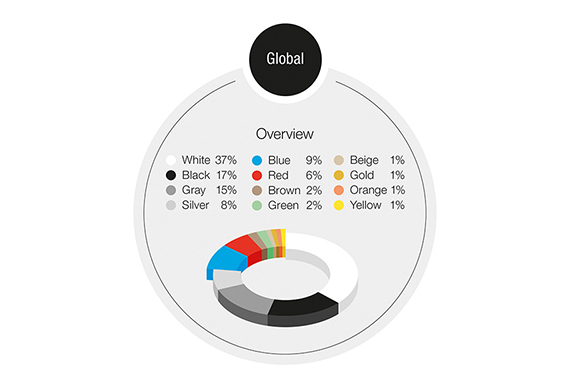
- Total vehicle production was lower, shifting the popularity of certain colours
- Blue and red are having a moment in the sun
- Despite the shift in colours, white, black, silver and grey follow a familiar pattern, coating the majority of the vehicles produced
In 2021, the automotive industry faced new challenges that it had never faced before. The total number of vehicles built on the world’s assembly lines in 2020 and 2021 was significantly lower than the years before. That put a sharper point on the popularity of certain colour spaces in the BASF Color Report 2021 for Automotive OEM Coatings, while knocking some perennial favourites down a few points.
The achromatic colours – white, black, grey, and silver – are still the most popular. They have classic, timeless beauty, and a connection to both the environment and high technology. But some cracks are showing in their armour as new colour spaces emerge.
As predicted by BASF’s designers years ago, blue is having a moment in the sun. Red is also rising – taking market share from the achromatic colours in many parts of the world. Even though the numbers are smaller, green and beige still show up in the data, and the colours aren’t the typical shades you might expect.
EMEA – Greater diversity of chromatic colours and shades
The share of chromatic colours in Europe, the Middle East, and Africa (EMEA) is now more than 27% and rising – the highest it’s been in two decades.
Blue is driving the trend among the chromatics. There are currently nearly 180 shades of blue from sky blue to midnight blue that are elegant, fresh, and young, and appear on all body types in all segments. Red is in second place, far behind blue, accompanied by a fair share of shades of green.
For the achromatic colours, white is still the most popular, but grey is catching up. Grey has several options, with effects and textures that multiply its presence. Grey’s 160 shades range from elegant, dark, sparkling colours to light and sporty solid colours.
"Colours designed for EMEA use familiar colour positions, but change them with the help of new effects, subtle colour gradients, or a specific sparkle behaviour. They make the chromatics stand out as bold expressions of individuality and sportiness, gaining popularity each year,” said Mark Gutjahr, head of Automotive Color Design, EMEA.
Asia Pacific – Leading the way in global colour diversity
White may still be the most popular colour in Asia Pacific (AP), but its popularity is starting to slip. Black and grey continue to improve, maintaining a four-year trend that is changing the presence of white vehicles on the road. A full 79% of new vehicles produced in AP were coated with achromatic colours in 2021.
The popularity of chromatic colours is stable, with some individual colour spaces adjusting a few points up or down. Blue – the number one chromatic colour – is up, mirroring global data from other regions. It took some share from red, which went down. Brown and gold show up in substantial numbers, while beige, orange, yellow, green and violet hang on with about 1% each.
"AP has the largest volume of automotive production in the world, and reflects the highest diversity of colour, compared to other regions,” said Chiharu Matsuhara, head of Automotive Design for AP. "Along with the surge in blue, the family of green colours increased. From teal to khaki to olive, these aren’t the usual greens, especially in SUVs.”
North America – Color preferences changing rapidly in the Americas
Blue appears to be moving on for North America. Its share is down 4% when compared to last year. That would put the preference for blue back to 2017 levels. Achromatic colours surged, including white, which increased in North America while declining globally, but not silver or grey, which are both down. Among the chromatic colours, red edged up 1%. Red and blue are now tied as the most popular chromatic colours.
Raw material shortages in 2021 forced automakers to make difficult choices while allocating scarce resources. That seemed to favour the larger, more popular platforms in the midst of the downturn.
"North America appears to change direction more quickly. With demand high and supply trending lower, buyers could be forced into making more pragmatic choices and fewer emotional choices. Consumers have quickly shifted to more familiar shades in the achromatic space,” said Paul Czornij, Head of Automotive Design for the Americas.
South America – Following the global direction
Blue is enjoying a global surge in popularity. In South America, blue increased by 3% in 2021, taking some of that market share from red. While car buyers in the region tend to be more conservative, some new shades are catching buyers’ eyes.
Automotive designers often look 3-4 model years ahead when developing colours. This is playing out as predicted, as South America tends to be slower to adopt colour direction than other regions.
"With an increase that large, blue is really establishing itself in South America. From sky blue to dark blue, more car buyers are moving into this colour family. We’re using some beautiful effects and pigments, especially metallics, that advance this important design space,” said Marcos Fernandes, Director BASF Coatings, South America.
The BASF Color Report for Automotive OEM Coatings is a data analysis from BASF’s Coatings division based on global automotive production and paint application to light vehicles in 2021.




